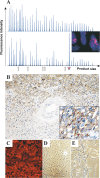EGFR and erbB2 in malignant peripheral nerve sheath tumors and implications for targeted therapy
- PMID: 18650488
- PMCID: PMC2719009
- DOI: 10.1215/15228517-2008-053
EGFR and erbB2 in malignant peripheral nerve sheath tumors and implications for targeted therapy
Abstract
Malignant peripheral nerve sheath tumors (MPNSTs) are sarcomas with poor prognosis and limited treatment options. Evidence for a role of epidermal growth factor receptor (EGFR) and receptor tyrosine kinase erbB2 in MPNSTs led us to systematically study these potential therapeutic targets in a larger tumor panel (n = 37). Multiplex ligation-dependent probe amplification and fluorescence in situ hybridization analysis revealed increased EGFR dosage in 28% of MPNSTs. ERBB2 and three tumor suppressor genes (PTEN [phosphatase and tensin homolog deleted on chromosome 10], CDKN2A [cyclin-dependent kinase inhibitor 2A], and TP53 [tumor protein p53]) were frequently lost or reduced. Reduction of CDKN2A was linked to appearance of metastasis. Comparison of corresponding neurofibromas and MPNSTs revealed an increase in genetic lesions in MPNSTs. No somatic mutations were found within tyrosine-kinase-encoding exons of EGFR and ERBB2. However, at the protein level, expression of EGFR and erbB2 was frequently detected in MPNSTs. EGFR expression was significantly associated with increased EGFR gene dosage. The EGFR ligands transforming growth factor alpha and EGF were more strongly expressed in MPNSTs than in neurofibromas. The effects of the drugs erlotinib and trastuzumab, which target EGFR and erbB2, were determined on MPNST cell lines. In contrast to trastuzumab, erlotinib mediated dose-dependent inhibition of cell proliferation. EGF-induced EGFR phosphorylation was attenuated by erlotinib. Summarized, our data indicate that EGFR and erbB2 are potential targets in treatment of MPNST patients.
Figures



Similar articles
-
PDGFRA, PDGFRB, EGFR, and downstream signaling activation in malignant peripheral nerve sheath tumor.Neuro Oncol. 2009 Dec;11(6):725-36. doi: 10.1215/15228517-2009-003. Neuro Oncol. 2009. PMID: 19246520 Free PMC article.
-
Suppression of proliferation of two independent NF1 malignant peripheral nerve sheath tumor cell lines by the pan-ErbB inhibitor CI-1033.Cancer Biol Ther. 2008 Dec;7(12):1938-46. doi: 10.4161/cbt.7.12.6942. Epub 2008 Dec 7. Cancer Biol Ther. 2008. PMID: 18927496 Free PMC article.
-
Expression of epidermal growth factor (EGF)/transforming growth factor-alpha by human lung cancer cells determines their response to EGF receptor tyrosine kinase inhibition in the lungs of mice.Mol Cancer Ther. 2007 Oct;6(10):2652-63. doi: 10.1158/1535-7163.MCT-06-0759. Epub 2007 Oct 3. Mol Cancer Ther. 2007. PMID: 17913856
-
The ErbB/HER family of protein-tyrosine kinases and cancer.Pharmacol Res. 2014 Jan;79:34-74. doi: 10.1016/j.phrs.2013.11.002. Epub 2013 Nov 20. Pharmacol Res. 2014. PMID: 24269963 Review.
-
Epidermal growth factor receptor (EGFR) targeted therapies in non-small cell lung cancer (NSCLC).Rev Recent Clin Trials. 2006 Jan;1(1):1-13. doi: 10.2174/157488706775246157. Rev Recent Clin Trials. 2006. PMID: 18393776 Review.
Cited by
-
Advances in antitumour therapy with oncolytic herpes simplex virus combinations.Discov Oncol. 2024 Jul 24;15(1):302. doi: 10.1007/s12672-024-01165-z. Discov Oncol. 2024. PMID: 39046631 Free PMC article. Review.
-
DNA damage response and repair genes in advanced bone and soft tissue sarcomas: An 8-gene signature as a candidate predictive biomarker of response to trabectedin and olaparib combination.Front Oncol. 2022 Aug 30;12:844250. doi: 10.3389/fonc.2022.844250. eCollection 2022. Front Oncol. 2022. PMID: 36110934 Free PMC article.
-
Interferon-Induced Transmembrane Protein 1 (IFITM1) Is Downregulated in Neurofibromatosis Type 1-Associated Malignant Peripheral Nerve Sheath Tumors.Int J Mol Sci. 2024 Aug 27;25(17):9265. doi: 10.3390/ijms25179265. Int J Mol Sci. 2024. PMID: 39273214 Free PMC article.
-
A Rare Case of Left Ventricular Malignant Peripheral Nerve Sheath Tumour-Case Report and Review of the Literature.Medicina (Kaunas). 2022 Oct 6;58(10):1404. doi: 10.3390/medicina58101404. Medicina (Kaunas). 2022. PMID: 36295565 Free PMC article. Review.
-
Establishment and characterization of a novel human malignant peripheral nerve sheath tumor cell line, FMS-1, that overexpresses epidermal growth factor receptor and cyclooxygenase-2.Virchows Arch. 2009 Dec;455(6):517-26. doi: 10.1007/s00428-009-0848-1. Epub 2009 Nov 18. Virchows Arch. 2009. PMID: 19921253
References
-
- Huson SM. Neurofibromatosis 1: a clinical and genetic overview. In: Huson SM, Hughes RAC, editors. The Neurofibromatoses. London: Chapman and Hall Medical; 1994. pp. 160–203.
-
- Legius E, Dierick H, Wu R, et al. TP53 mutations are frequent in malignant NF1 tumors. Genes Chromosomes Cancer. 1994;10:250–255. - PubMed
-
- Holtkamp N, Okuducu AF, Mucha J, et al. Mutation and expression of PDGFRA and KIT in malignant peripheral nerve sheath tumors, and its implications for imatinib sensitivity. Carcinogenesis. 2006;27:664–671. - PubMed
Publication types
MeSH terms
Substances
LinkOut - more resources
Full Text Sources
Other Literature Sources
Research Materials
Miscellaneous

